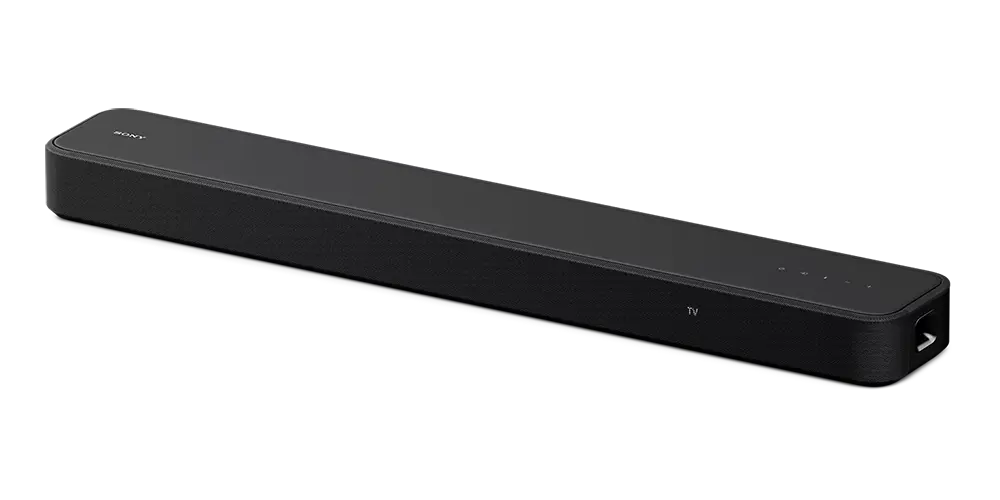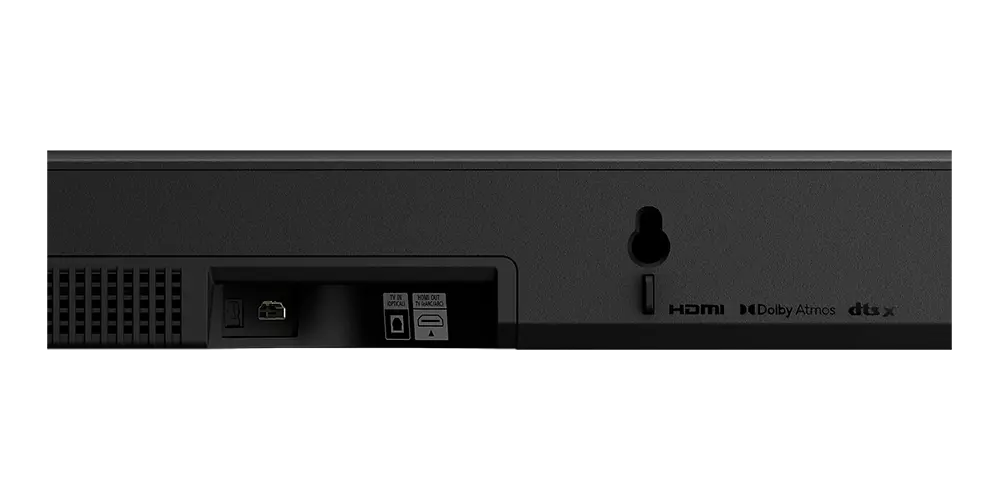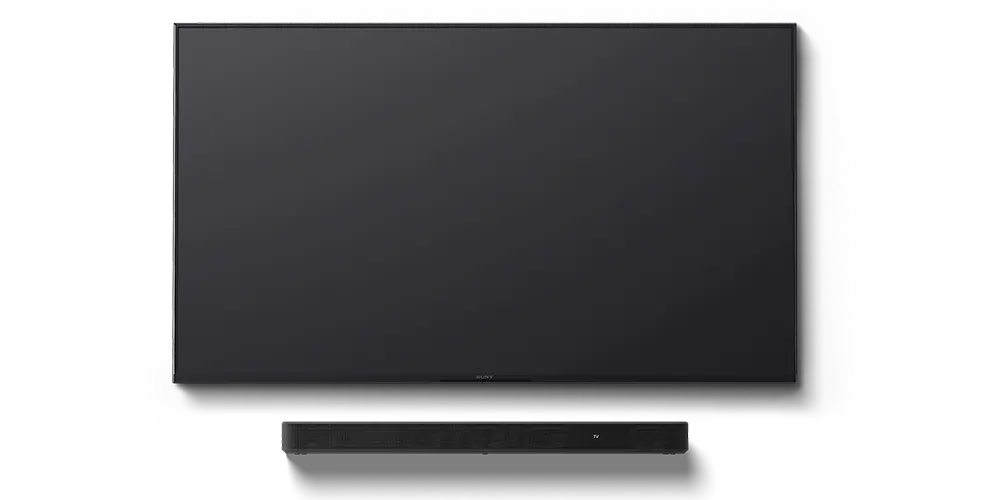Sony is expanding the core of its soundbar range with the HT-S2000, a 3.1 model with an integrated subwoofer and Dolby Atmos and DTS:X compatibility, but without vertical transducers. The manufacturer relies on software processing to give the illusion of immersive sound.
- Appropriate tonal balance
- Intelligible dialogue
- Easy to use
- Moderate power consumptio
- Design and build quality
- No vertical dimension despite Dolby Atmos compatibility
- Only one HDMI socket
- High price compared to the performance
Dolby Atmos has become the marketing argument to be applied almost systematically to all new soundbars. This format, which allows sound to circulate above the listener, is nevertheless challenging to implement in a sound bar, as it is so tricky to give the listener the illusion that the sound is coming from the ceiling, with a speaker housed under the television.Soundbars and wireless speakers capable of creating the famous Dolby Atmos vertical ambience are rare. Seheiser Ambeo Soundbar Plus,
Sonos Era 300 or JBL Boombox 3 Wi-Fi achieve this to a certain extent, with many transducers aimed in all directions and combined with sophisticated digital processing of the audio signal. The Sony HT-S2000 bar isn't up to the Dolby Atmos challenge without vertical transducers. It does, however, have other qualities.
The Sony HT-S2000 soundbar has classic lines with slightly rounded edges. Its front panel is covered by an acoustic grille that conceals the transducers and white LED display, while the rest of the speaker body is made of matt black plastic with a grained finish on the rear panel. The top panel features a touch-sensitive control zone on the right, with the option of adjusting the volume or selecting an input. Coections are housed in two recesses on the rear for easy wall mounting.The remote control supplied is compact and well laid out, with all the buttons accessible without too much contortion of the thumb. Although it is not backlit, a small pin makes it easy to locate the volume control. There's also access to low-frequency level adjustment, night mode (dynamic compression) and Voice mode for enhanced dialogue.

Sony has housed five oblong transducers in the HT-S2000 in a 3.1 configuration. In other words, this bar distributes the left, centre and right channels with three transducers and the low-frequency chael (LFE/.1) with two transducers. The latter two are isolated in a dedicated bass-reflex tuned volume.As a reminder, the bass-reflex technique boosts the low-frequency output of loudspeakers by mechanically amplifying specific frequencies using resonator tubes, which in the case of the HT-S2000, open out at the lateral ends of the enclosure. The five transducers are identical and theoretically guarantee sound homogeneity when certain sounds move from left to right. The first disappointment is that this bar needs to employ a tweeter to refine the reproduction of high frequencies and give the sound greater precision. This is a shame because conventional transducers, such as those fitted to the soundbar, caot increase the frequency with the same rigour as a tweeter.Another point to note is that the absence of transducers directed towards the room's edges and the ceiling seems incompatible with sound positioning to the sides and above the listener and, therefore, by extension, with Dolby Atmos or DTS/X formats.

The Sony HT-S2000's connectivity is sparse, with a single HDMI socket and an optical Toslink input. The latter allows you to coect the bar to a TV that doesn't offer audio return or to an external source such as a DVD or Blu-ray player. The HDMI socket is compatible with ARC and eARC audio return and with the CEC protocol for controlling the bar's volume using the TV remote control. If you want to enjoy Dolby and DTS HD, Dolby Atmos or DTS:X sound, you'll need to pair this bar with an eARC-compatible TV; otherwise, you'll only get conventional Dolby and DTS 5.1.The Sony HT-S2000 also incorporates a Bluetooth receiver for listening to music, using a smartphone, and controlling the bar using the Sony Home Entertainment Center mobile application. Finally, the power supply is integrated into an external power supply unit. The bar has a USB-A port for technical maintenance.

Sony has equipped its bar with Vertical Surround Engine and S-Force Pro Front Surround technologies. Theoretically, the Vertical Surround Engine allows a soundstage to be created above the listener from single stereo programs. In contrast, the S-Force Pro Front Surround allows a surround soundstage (side/rear) to be established without needing additional wireless speakers. However, the HT-S2000 can be used with the optional Sony SA-RS3S surround speakers (€399).Most of the bar's settings can be accessed from its remote control (surround mode, dialogue enhancement, sound compression, bass adjustment, etc.). Still, they are also available in the Sony Home Entertainment Center app. You'll need to use this app to access the bar's advanced settings.With it, you can update the speaker firmware, activate the DSEE mode (to improve high-frequency dynamics), adjust the dialogue level (on DTS signals only) or activate automatic volume management or automatic compression of Dolby signals to even out any differences in status.

II tested the Sony HT-S2000 (firmware 1.878) in a 30m² living room, a small attic room, and a television and a video projector.The HT-S2000's sound performance is decent, but this bar doesn't shine for any distinctive quality. Unsurprisingly, the need for tweeters mentioned above affects the fluidity of the sound message. It's clean, but the sound lacks subtlety and pep in the treble. Despite an integrated 'subwoofer', bass performance is barely passable, and there's not much below 100 Hz.Our measurement curves show that the downward extension of the spectrum is limited and that the bar also emphasises the upper bass (peaking at around 100 Hz), which makes the bass punchy but removes any impression of depth. In other words, scenes in films and TV series involving impacts or rumbles are played without flavour. It's easy to see why Sony offers two optional subwoofers for the HT-S2000: the SA-SW3 and SA-SW5, priced at €499 and €799, respectively. I want to say a few more words about the absence of a tweeter, drawing your attention to the apparent differences between the three curves and the collapse of the transducers in the treble as the volume is increased. While the blue curve (moderate level) shows a generally linear rise in frequency, the pink and orange curves (sustained and maximum volume) show that at high levels, the transducers caot reproduce the highest frequencies.

Despite the Vertical Surround Engine and S-Force Pro Front Surround technologies and support for Dolby Atmos, this bar delivers essentially frontal sound with no elevation or immersion. This promise is disappointing because the integrated subwoofer caot deliver sub-bass. The Sony HT-S2000 is not a bad sound bar, but its performance is that of an entry-level bar, so the price seems excessive.
https://sony.scene7.com/is/content/sonyglobalsolutions/HT-S2000_final_video





